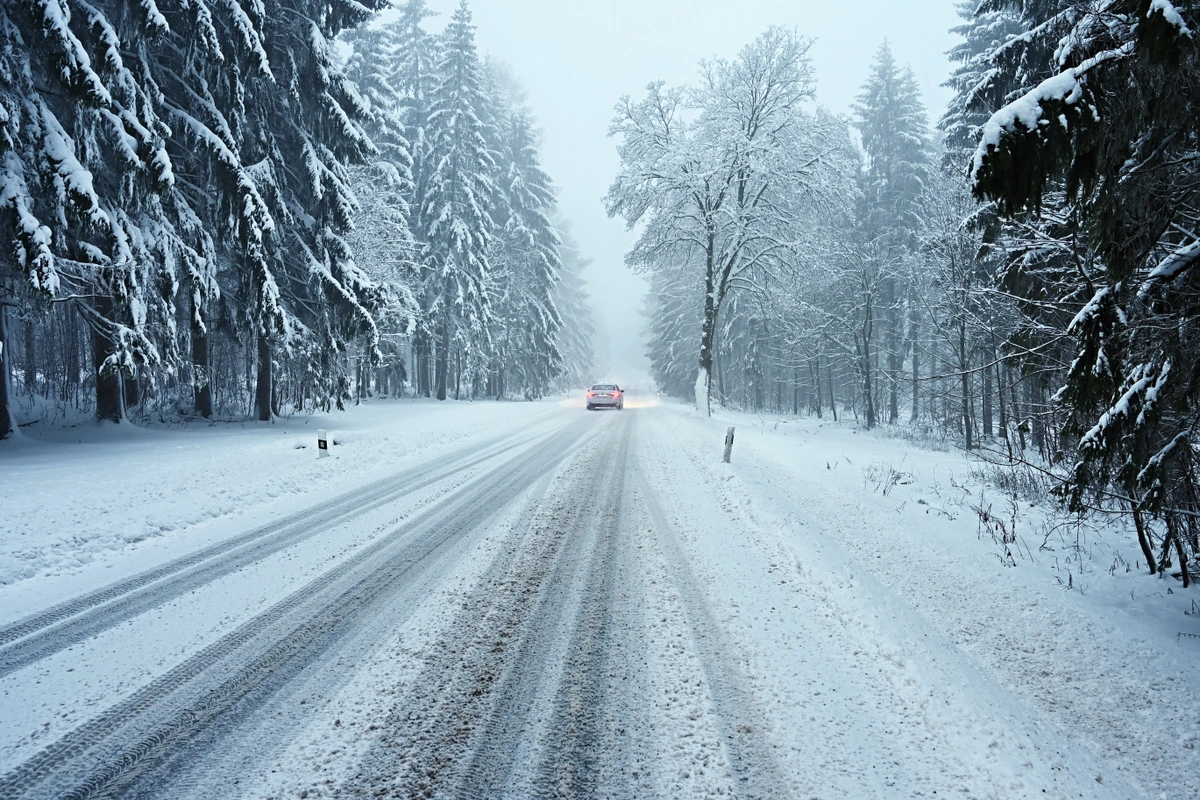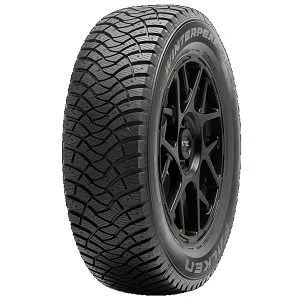By Tire Agent Staff
September 29, 2023
We thought an article about studding tires might be relevant to maybe afew areas in the United States, until we looked at a map on the US DOT's site and learned that 70% of roads in the US are located in snowy regions. Even Arizona, one of the hottest states in the country, sees snow every year. The high elevations in Flagstaff, Sedona, and the Grand Canyon area see snow every winter, with northern parts of the state reporting as much as 75 inches of snow every year.
So, what's the difference between snow tires and studded tires? And, do you need studded snow tires?
What Are Tire Studs? What Are Studded Tires?
Studded tires are winter tires that have been fitted with cleat-like protrusions that provide even more grip than snow tires. Some snow tires come fixed with studs, while others are called "studdable," meaning they have divots where you can install studs on snowy and icy days.
Who Makes Studded Tires?
You can find winter tire with studs through Tire Agent. Select "SHOP" from any page, enter your vehicle information and then filter to studded tires or studdable tires. These are among the best options for studded and studdable tires. Approximate costs for studded snow tires are included. Prices are always subject to change.
Falken
- Falken WinterPeak F-ICE 1: Pinned for studs, starting at around $103 per tire
Firestone
- Firestone WinterForce 2: Pinned for studs, starting at around $119 per tire
General Tire
- General AltiMAX Arctic 12: Pinned for studs, starting at $115 per tire
- General Grabber Arctic: Pinned for studs, starting at $199 per tire
- General Grabber Arctic LT: Pinned for studs, starting at $222 per tire
Goodyear
- Goodyear Ultra Grip Winter: Fitted for metal studs, starting at around $102 per tire
Hankook
- Hankook Winter i*Pike RS W419: Studdable, starting at around $88 per tire
- Hankook Winter i*Pike RW09: Pinned for studs, starting at $273 per tire
Laufenn
- Laufenn I FIT Ice: Studdable winter tire, starting at around $96 per tire
Nokian 
- Nokian Hakkapelitta 8: Built-in studs, starting at $124 per tire
- Nokian Hakkapelitta 9: Built-in studs, starting at $181 per tire
- Nokian Hakkapelitta 9 SUV: Built-in studs for sport utility vehicles, starting at $197 per tire
- Nokian Hakkapelitta C3: Built-in studs for commercial vehicles, starting at $166
- Nokian Hakkapelitta R3: Studded, starting at $148 per tire
- Nokian Nordman 7: Studded, starting at $170 per tire
- Nokian Nordman 7 SUV: Studded for SUVs, starting at $342 per tire
Sumitomo
- Sumitomo Ice Edge: Pinned for studs, starting at $79 per tire
Toyo
- Toyo Observe G3 Ice: Studdable tire, starting at $53 per tire
Answers to FAQs About Studded Tires
What are the differences between snow tires vs studded tires?
Snow tires, or stud-less winter tires, are built with deeper grooves and sharp, jagged edges. This optimizes traction, making it safer to drive in snow. Snow tires are designed to grip the ground through snow, slush and ice, and the tread compound will stay flexible in temperatures that dip below 45 degrees Fahrenheit.
Snow tires are perfect for people who live in areas that have long cold winters and see reasonable amounts of snow.
What are studless snow tires?
Studless snow tires are winter tires with deeper treads that are designed to help move vehicles through snow and slush. Simply put, studless snow tires are snow tires without studs. No, you cannot add studs to regular tires or to tires that are not studdable, which we'll describe next.
What are studdable snow tires?
Studdable snow tires come with divots that accommodate removable studs so they can be added during severe snowy weather and removed when the snow melts.
What are the benefits of studs for winter tires?
If you're driving in areas that see more extreme winter conditions or if you live in a mountainous or hilly area, you'll want to consider studded winter tires. Like traditional snow tires, studded winter tires are built with deeper grooves and sharp, jagged edges to optimize traction, making it safer to drive in snow.
However, studded tires include studs for enhanced traction on ice. Think of them like cleats you'd see on baseball players: small, round pieces of rubber, plastic or metal that provide better grip by digging into the road.
Studded tires are built for driving in slippery, heavy snow, and ice.
Can you stud any tire?
No, any tire cannot be studded. No matter what your long-winded uncle says, you cannot stud standard winter tires (or any tire other than a studdable tire).
If you want the safety of studded tires but don't need the studs all the time, you can get what's known as a hybrid option, also known as "studdable."
Some studdable tires come with studs that you can screw into the predrilled holes in the tire's tread. Others come with the holes and you have to buy the studs separately. Do this when a heavy winter storm is on the way, and simply remove the studs when driving conditions are safer.
So, why would you want studdable tires?
The primary reason to have hybrid studdable tires is to have the best of both worlds. You have the flexibility to add studs when weather conditions demand them, and then remove them when you don't need them.
But that's not the only rationale. Honestly, not all states permit studded tires. Yep. It's illegal to have studded tires on your vehicle in some states, and some places allow studded tires only during certain times of the year.
For example, Ohio allows them from Nov. 1 to April 15. Arkansas allows them from Nov. 15 to April 15, and Virginia allows them from Oct. 15 to April 15.
According to the U.S. Tire Manufacturers Association, states that don't permit studded tires include:
- Hawaii
- Illinois
- Michigan
- Minnesota
- Mississippi
- Wisconsin
As you know, laws change all the time. So check with your state's bureau of motor vehicle office before deciding.
How many studded tires do you need? 4? Or, are 2 enough?
You never want to have only two snow or studded tires. Some may think it would be acceptable just to put them in the front, since most vehicles are front-wheel drive. But that's a bad idea.
Having snow tires only in the front could result in having less control driving your car. It increases the possibility of oversteering or fishtailing around corners. You might even lose control applying the brakes.
If you have a rear-wheel drive vehicle, you might be able to get away with installing two studded tires in the back. But it's not recommended. For optimal performance, you need four matching tires.
Why aren't all-season tires enough for snow?
Most vehicles have all-season tires when driving off the lot. That's because all seasons are the most versatile tires, designed for smooth rides in most North American weather conditions. They're perfect for anyone living in warm weather climates, four-season climates that don't see much snow, and if you live in a winter climate but don't drive much.
Bottom line: If you drive in areas that get deep snow, cold weather, and lots of ice, you're going to need a tire that adapts to those conditions, especially if you commute to work or drive every day. That's when you'll want to look into snow tires or studded tires.
Bottom Line: Are Studded Tires Worth It?
Studded tires are a good choice if you live in an area with heavy snow and ice, especially if you prioritize safety and handling over road noise. Studded tires can be louder than all-season or non-studded snow tires. Don't try to stud non-studded or non-studdable tires. If cost is a factor, Tire Agent offers a number of easy payment plans, some of which require no money down and light to no credit checks. If you live in South Florida, no, studded tires aren't worth it. If you live in the Allegheny Mountains of Pennsylvania, the Rockies in Colorado or even the slippery roads of the Midwest, then yes, studded tires maybe worth it if local laws allow them.
Photo137087801| Montypeter|Dreamstime.com
Next Post:
Buy Tires and Wheels with Affirm


